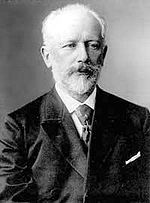- The Enchantress (opera)
-
Operas by
Pyotr Ilyich Tchaikovsky
The Voyevoda (1868)
Undina (1869)
The Oprichnik (1874)
Vakula the Smith (1876)
Eugene Onegin (1879)
The Maid of Orleans (1881)
Mazeppa (1884)
Cherevichki (1887)
The Enchantress (1887)
The Queen of Spades (1890)
Iolanta (1892)The Enchantress (or The Sorceress, Russian: Чародейка, Charodéyka) is an opera in four acts by Pyotr Tchaikovsky based on the libretto by Ippolit Shpazhinsky, using his drama with the same title. The opera was composed between September 1885 and May 1887 in Maidanovo, Russia and received its first performed in St Petersburg in 1887.
Contents
Performance history
The world premiere was given on 11 November 1887 [OS October 20] at the Mariinsky Theatre in Saint Petersburg conducted the composer and with stage direction by Osip Palechek (Josef Paleček), set designs by Mikhail Bocharov; and costume designs by E. Ponomaryov.
Other notable performances include the Moscow premiere at the Bolshoy Theatre in 1890, followeded by two others in that city in 1900 and 1913.
Roles
Role Voice type Premiere cast
11 November 1887
Conductor: the composer)Prince Nikita Kurlyatev, the Grand Prince's deputy in Nizhniy-Novgorod baritone Ivan Melnikov Princess Yevpraksiya Romanovna, his wife mezzo-soprano Mariya Slavina Prince Yuriy, their son tenor Mikhail Vasilyev Mamïrov, an old deacon bass Fyodor Stravinsky Nenila, his sister, a lady-in-waiting to the princess mezzo-soprano Ivan Zhuran, valet of the prince bass-baritone Nastasya, nicknamed "Kuma", keeper of a wayside inn at a crossing of the Oka River, a young woman soprano Emilia Pavlovskaya Foka, her uncle baritone Polya, her friend soprano Balakin, a guest from Nizhniy-Novgorod tenor Potap, a merchant guest bass-baritone Lukash, merchant guest tenor Kichiga, a pugilist bass Payísy, a vagabond in the guise of a monk character tenor Kudma, a sorcerer baritone Chorus, silent roles: Maidens, guests, police officers, serfs, huntsmen, skomorokhi, people Instrumentation
Source: www.tchaikovsky-research.net
- Strings: Violins I, Violins II, Violas, Cellos, Double Basses
- Woodwinds: Piccolo, 3 Flutes, 2 Oboes, Cor Anglais, 2 Clarinets (B-flat, C, A), 2 Bassoons
- Brass: 4 Horns (F), 2 Cornets (B-flat), 2 Trumpets (B-flat), 3 Trombones, Tuba
- Percussion: Timpani, Triangle, Tambourine, Military Drum, Cymbals, Bass Drum, Tam-tam
- Other: Harp
- On/Offstage: 4 Horns (off)
Synopsis
Time: The last quarter of the 15th century
Place: Nizhny Novgorod and its vicinity
The action takes place at the last quarter of the 15th century at the tavern and brothel near Nizhny Novgorod. Nastasia (Kuma), the charming owner of the inn, has made herself an enemy in rejecting the devious Mamyrov, the right-hand man of the local governor Nikita Danilovich Kurliatev. He spreads the gossip that Nastasia is an enchantress, and every man whom she meets falls for her. Yuri, Nikita's son, begins to frequent the inn, as does his father, who falls madly in love with Nastasia (without any success), who threatens her that he will reach his goal by whatever means. Mamyrov confronts Nikita's wife, Evpraksia, with the truth, while her son – not yet personally involved with Nastasia – swears to avenge his mother. While confronting Nastasia he learns that it is he whom she loves. They both plan to flee during the night not knowing that, by now, Mamyrov has worked out an elaborate plot to wreak his revenge on Nastasia as well as on Nikita and his family with devastating effect.
- Introduction
Act 1
- Folk Scene (No. 1)
- Folk Scena (No. 2)
- Chorus of Guests & Scene (No. 3)
- Scene (No. 4)
- Kuma's Arioso (No. 4a)
- Folk Chorus & Scene (No. 5)
- Scene (No. 6)
- Decimet (No. 7a)
- Scene & Chorus (No. 7b)
- Dance of the Tumblers (No. 7c)
Act 2
- Entr'acte
- Scene & Princess's Arioso (No. 8)
- Scene & Duet (No. 9)
- Scene (No. 10)
- Scene (No. 11)
- Prince's Arioso (No. 11a)
- Scene: Prince with the Princess (No. 12)
- Folk Scene (No. 13)
- Finale (No. 14)
Act 3
- Scene & Duet (No. 15)
- Scene (No. 16)
- Scene (No. 17)
- Duet (No. 17a)
Act 4
- Entr'acte
- Scene with Chorus (No. 18)
- Scene & Duet (No. 19)
- Scene (No. 20)
- Kuma's Arioso (No. 20a)
- Scene & Duet (No. 21)
- Scene & Quartet (No. 22)
- Finale (No. 23)
Versions by other hands
In the Soviet Union, the opera was staged again with a new version of the libretto by Sergey Gorodetsky after Shpazhinsky on March 22, 1941 in Leningrad (St Petersburg).
Recordings
- 1954, Natalya Sokolova (Nastasya), Mikhail Kiselyov (Prince Kurlyatev), Vera Borisenko (Princess Yevpraksiya), Georgiy Nelepp (Prince Yuriy), Aleksey Korolyov (Mamïrov), Anna Matyushina (Nenila), Mikhail Skazin (Ivan Zhuran), Anatoly Tikhonov (Foka), Vera Gradova (Polya), Sergey Sladkopevtsev (Balakin), Leonid Khachaturov (Potap), Aleksey Usmanov (Lukash), Gennady Troitsky (Kichiga), Pavel Pontryagin (Payisy), Pavel Korobkov (Kudma), Moscow Philharmonia State Orchestra, Radio USSR chorus, Samuil Samosud (conductor)
- 1978, Rimma Glushkova (Natasya, the enchantress), Oleg Klenov (Prince Kurlyatev), Lyudmila Simonova (Princess Yevpraksiya), Lev Kuznetsov (Prince Yuriy), Yevgeny Vladimirov (Mamirov), Nina Derbina (Nenila), Boris Dobrin (Ivan Zhuran), Pyotr Gluboky (Foka), Galina Molodtsova (Polya), Vladimir Makhov (Balakin), Sergei Strukachev (Potap), Lev Eliseyev (Lukash), Vladimir Matorin (Kichiga), Andrei Sokolov (Payisy), Viktor Ribinsky (Kudma), Moscow Radio Symphony Orchestra and Chorus, Gennady Provatorov (conductor)
- VHS 1984 (DVD 2010), Larissa Zyryanova (Nastasya, the enchantress),Vladimir Stepanov (Prince Kurlyatev), Lyudmila Korzhakova (Princess Yevpraksiya), Vadim Valyuta (Prince Yuriy), Alexander Pravilov (Mamirov), A. Perfilova (Nenila), E. Sedov (Ivan Zhuran), Dimitri Sukhanov (Foka), L. Lebedovskaya (Polya), N. Bogutsky (Payisy), A. Burlatsky (Balakin), M. Sanotsky (Potap), Mikhail Larin (Lukash), A. Perfilov (Kichiga) Nizhegorodsky State Academic Theatre of Opera and Ballet, Pavel Reznikov.
External links
Categories:- Russian-language operas
- Operas by Pyotr Ilyich Tchaikovsky
- Operas
- 1887 operas
Wikimedia Foundation. 2010.

